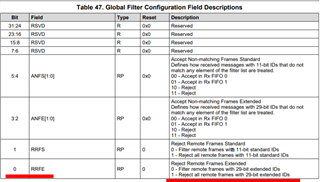Other Parts Discussed in Thread: TCAN4550
Hi team,
If I want to reject communication from only the extended ID, is this BIT correct?
And, what is the RP(type) mean?
Is it Read/Protect write?
So, how to write this register?
Sincerely.
Kengo.
This thread has been locked.
If you have a related question, please click the "Ask a related question" button in the top right corner. The newly created question will be automatically linked to this question.
Hi team,
If I want to reject communication from only the extended ID, is this BIT correct?
And, what is the RP(type) mean?
Is it Read/Protect write?
So, how to write this register?
Sincerely.
Kengo.
Kengo,
This bit will reject remote frames with an extended ID, not all frames. The difference between a remote frame and a data frame is the remote frame has no data field, and the RTR bit in the frame is recessive, where in a data frame it is dominant. You can set up your filters so they only accept standard ID frames vs. extended when you configure your memory space.
Read/Protected Write means that this register can be written to when bits 0 and 1 in register 0x1018 are set to 1.
Regards,
Eric Hackett
Hi Kengo,
Setting up SID and XID (standard and extended ID) filters is done during the configuration of the MRAM in TCAN4550. During this step, the number of SID and XID elements are defined (as well as the number and size of RX/TX FIFOs and buffers). After this, the correct number of filters must be written to MRAM. If no XID filters are set, then extended frames will not be stored in memory. A SID filter(s) must be defined in order for the device to store received standard ID CAN frames.
Page 13 (Section 4.2.3) of the TCAN4550 software user's guide describes the layout and use of these filters. An example of both SID and XID configurations can be found in the Init_CAN() function of the demo code.
Regards,
Eric Schott